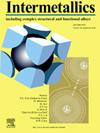Enhanced corrosion resistance of gradient structured CoCrFeMnNi high entropy alloy by laser surface heat-treatment process
IF 4.3
2区 材料科学
Q2 CHEMISTRY, PHYSICAL
引用次数: 0
Abstract
The corrosion behavior of the gradient structured CoCrFeMnNi high entropy alloys (HEAs) which has excellent strength-ductility synergy is investigated in this study. Compared to the conventional fine-grained and coarse-grained structures, the gradient structured CoCrFeMnNi HEAs exhibits better corrosion resistance, which can be demonstrated by the highest corrosion potential of ∼−0.34 V, lowest corrosion current density of ∼1.07×10−7 A/cm2, maximal impedance modulus of ∼4.72×104 Ω·cm2, maximum charge transfer resistance of ∼3.41×105 Ω·cm2, least serious corrosion pits, and smallest corrosion rate of ∼7.384 g·m−2·h−1. The passive film generated on the gradient structured sample which is characterized by low density of charge carrier has relatively high content of Cr/Fe oxides and bound water, along with the low content of Mn oxide. The enhanced corrosion resistance in the gradient structured CoCrFeMnNi HEAs is mainly attributed to the interaction between soft surface severed as cathode and anode zone characterized by relatively high microhardness in middle region. That is, the cathodic soft region combined with the high-density grain boundary of central region accelerates the formation of passive film with higher Cr content on the hard center layer, while the anodic hard zone improves the anti-corrosion of soft layer due to the cathodic protection and transferred electrons. Therefore, gradient structure is a great method to simultaneously increase the strength-ductility synergy and corrosion resistance, suggesting a promising prospect for industrial applications.
求助全文
约1分钟内获得全文
求助全文
来源期刊

Intermetallics
工程技术-材料科学:综合
CiteScore
7.80
自引率
9.10%
发文量
291
审稿时长
37 days
期刊介绍:
This journal is a platform for publishing innovative research and overviews for advancing our understanding of the structure, property, and functionality of complex metallic alloys, including intermetallics, metallic glasses, and high entropy alloys.
The journal reports the science and engineering of metallic materials in the following aspects:
Theories and experiments which address the relationship between property and structure in all length scales.
Physical modeling and numerical simulations which provide a comprehensive understanding of experimental observations.
Stimulated methodologies to characterize the structure and chemistry of materials that correlate the properties.
Technological applications resulting from the understanding of property-structure relationship in materials.
Novel and cutting-edge results warranting rapid communication.
The journal also publishes special issues on selected topics and overviews by invitation only.
 求助内容:
求助内容: 应助结果提醒方式:
应助结果提醒方式:


